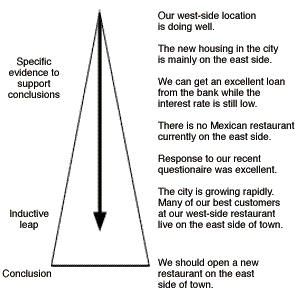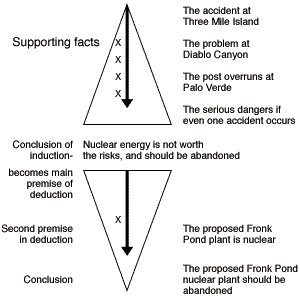| ENG302
: The Class
: Forms and Formats
: Formal
: Overview
Lesson and Overview for this Topic Formal ReportsIn Topic 1 (in this module), you wrote a prospectus for your final project. In this final topic, you will write a formal, elaborate report. Remember, you chose from one of the following: A. A thesis report: A report which has an arguable main point, supported by hard data and possibly other types of evidence. As introduced in the previous topic, all reports have in common that they are transmitting information to a specific audience, for a specific purpose, in short, an arguable point, supported by a collection of data, which "proves" that point. Letís look more closely at the word "proves." To achieve proof, you must do three things: 1. Gather enough volume of data to make your case solid. Letís look at each of these three points in detail: 1. Gather enough volume of data to make your case solid. You have a working outline of your entire report. In this outline are the various subparts of your argument. Each subpart must have hard evidence to back it up. The best hard evidence is numbers and statistics; however, many other types of effective evidence also exist, such as expert testimony and opinion, examples and illustrations, analogies, case studies, pictures, charts, and graphs, and logical arguments. You must find as much hard evidence as you can in each subpart of your argument. It is far better to have too much evidence and have to cut some out than to have too little evidence and risk not having a convincing case. 2. Organize the data into logical and supporting patterns. Under each subpart, you must select a pattern of organization for the data. Two of the best patterns are inductive and deductive. In the inductive pattern, you organize the data from most specific to most general, or in other words you build your case from individual pieces of data upward toward broader conclusions.  In the deductive pattern, you organize the data from assumptions downward toward conclusions. Typically, you start with one assumption and a limited amount of related data leading to a specific conclusion.  3. Control the data by integrating your own personal insights into it so that it works for your case instead of just sitting there. In the assignment for this topic, you will find more information to help you organize your formal report. Please study it carefully, and use it as you continue your work. Once you have finished reading this, you should: Go on to the first assignment E-mail Greg Larkin at
Gregory.Larkin@nau.edu Web site created by the NAU OTLE Faculty Studio
Copyright 1998
Northern Arizona University |